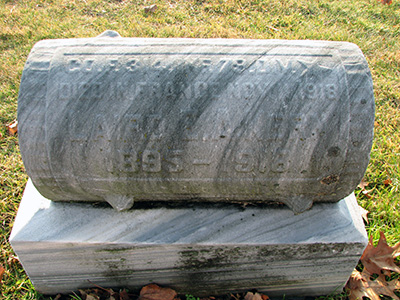
Laird Elias Kern grave, Union Cemetery, Neffs, Pennsylvania; image credit
Laird Elias Aaron Kern (26 August 1895 - 11 November 1918) was the son of James Monroe Kern (1869-1939) and Cora Remaley (1876-1900). He was born in Slatington, Pennsylvania and grew up in the lower part of town. It was a large family, and he did some work as a farmer.
In September 1917, as part of the second call of the draft, Kern accepted and did not claim an exemption. On the evening of 27 December 1917, Rev. J. H. Longacre, in his parsonage, united Laird Kern and Annie Kistler of Newside (just outside of Neffs, Pennsylvania) in marriage. They had one daughter, Marian Ida Kern (1918-1952). Annie Kistler (1897-1930) later remarried Warren E. Kelchner (1888-1948).
Kern served in Company F, 314th infantry regiment, 157th infantry brigade, 79th infantry division (5th corps, 1st army) and participated in the Meuse-Argonne offensive of September-November 1918. The division, with men from Eastern Pennsylvania, Maryland and the District of Columbia, was one of sixteen divisions created in 1917. After initial training at Camp Meade, Maryland, the division departed for France from Hoboken, New Jersey in July 1918. Training resumed once in France.
At 0630 AM on 26 September 1918, the 314th regiment attacked as part of the first phase of the Meuse-Argonne offensive. The start position was Le Mort Homme (Dead Man’s Hill), famed from the Battle of Verdun, and the regiment’s goal was the town of Montfaucon. During the ensuing offensive, the regiment suffered heavy losses not only in battle but also from disease like the Spanish Flu. While initially numbering about 3,600 men, by the end of the war in November the regiment was down to approximately 1,980.
Kern’s regiment also participated in the second, third and fourth phases of the battle. It is not clear exactly when Kern received the wounds that would result in his death. That might have happened in the round of attacks that began on 1 November, or it might have been in the assault on Hill 319 (côte 319) on 9-10 November, or it might have happened early on the morning of 11 November.
Fighting continued right up until the 11 AM armistice on 11 November. On the night of 10-11 November, the division received orders to advance on the Côte de Romagne at 0930 AM. The “morning found Hill 319 and the surrounding knolls and valleys covered with a sea of dense fog …. Orders [were] to advance toward Côte de Romagne, the last hill and strongest natural defense in the area.” Company F was to form the first wave on the right flank.
A short time before dawn on the 11th, the division commander received news from General Foch that hostilities would cease at 11 AM, and at 0900 the division headquarters sent a message out to brigade commanders that “Hostilities will cease on the whole front at 11h, today, French time. Until that hour the operations previously ordered will be pressed with vigor.” (Foch, Page 314)
Private Kern died that morning, along with 320 other Americans soldiers (and more than 3,240 seriously wounded) in the very last hours of the last day of the war. (Joseph Persico, "Nov. 11, 1918: Wasted Lives on Armistice Day," (https://www.armytimes.com/veterans/salute-veterans/2017/11/10/nov-11-1918-wasted-lives-on-armistice-day/) He was twenty-three years old.
Private Kern was originally buried in the French Military Cemetery, Verdun-sur-Meuse, France, before being re-interred in Union Cemetery, Neffs, Pennsylvania.
Draft registration listed occupation: farmer
Draft registration listed home address: 376 Walnut St., Slatington, Pennsylvania
Family
father James M. Kern, 1869-1939
mother Cora E. Remaley, 1876-1900
sister Wilma M. Kern, 1899-1955 (Hendrickson)
step-mother Ida S. Rauch, 1875-1951
step-brother Llewelyn Leon Henry Kern, 1902-1903
step-sister Estella Ida Susanna Kern, 1905-1905
step-brother Elwood Henry Andrew Adam Kern, 1907-1916
step-sister Arline Miriam Kern, 1912-1912
step brother Clarence James Monroe Kern 1913-1978
wife Annie Kistler, 1897-1930 (Kelchner)
daughter, Marian I. Kern, 1918-1952